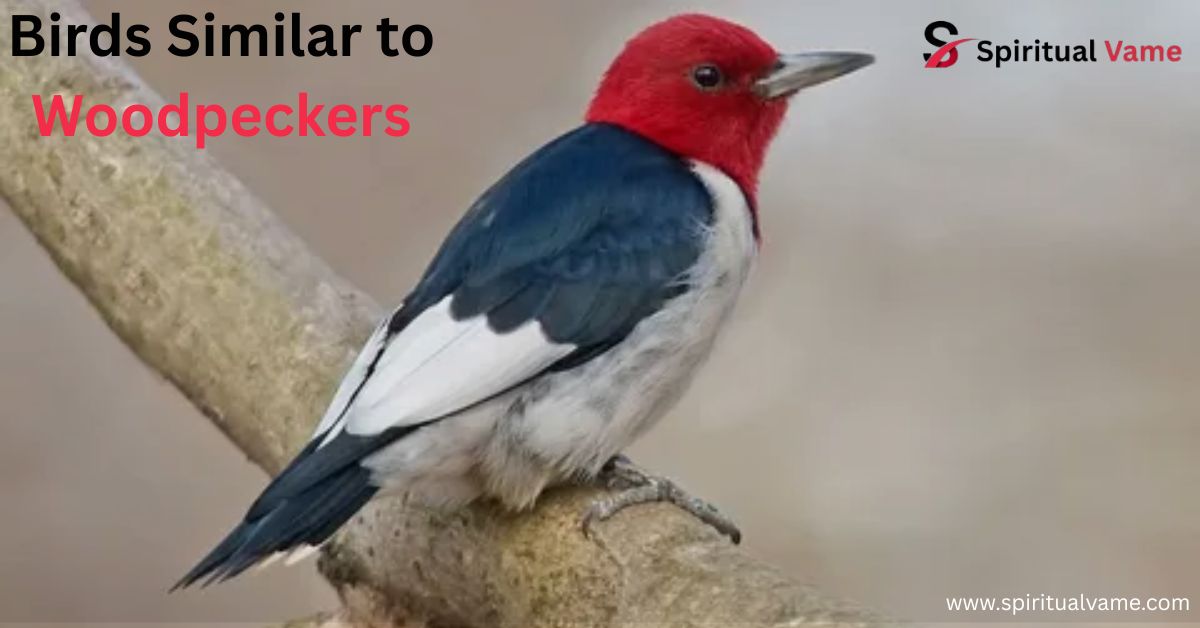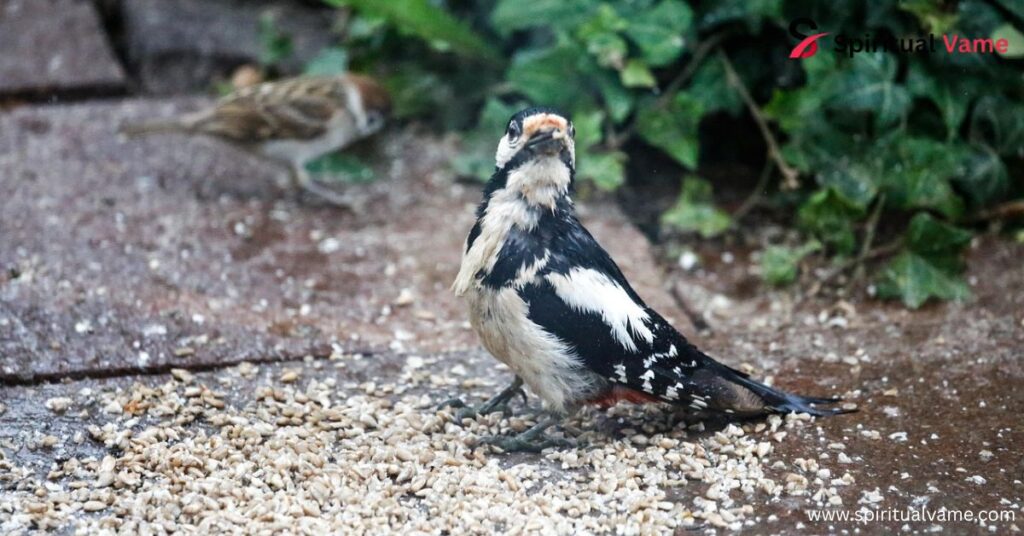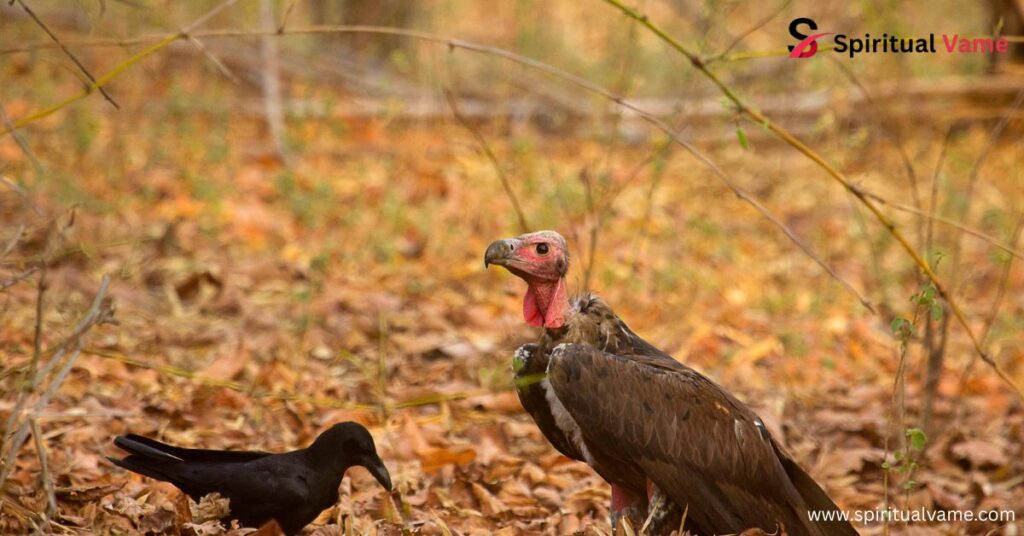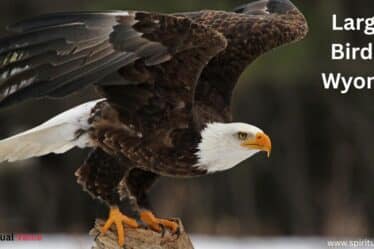
Birdwatchers across the U.S. often ask why some birds behave just like woodpeckers. The answer lies in evolution and behavioral adaptation. Birds such as sapsuckers, flickers, and even certain finches have learned to mimic feeding strategies like excavation and sap-feeding. They’ve developed similar beak shapes, head movements, and even territorial calls. This natural mimicry is a survival technique, letting them thrive in shared habitats.
The list below explores birds that either belong to the woodpecker family or strongly resemble it. From the bold Sphyrapicus ruber to the widespread Northern Flicker, each species brings something special to the birding experience. Their plumage, nesting style, and communication behaviors make them worthy of a closer look. Let’s dive into the unique features and habitats of these 11 bird species.
1. Red-Breasted Sapsucker – Sphyrapicus ruber
This bird is often found in the Pacific Northwest and is famous for its bright red head and upper chest. The Red-Breasted Sapsucker drills neat rows of holes into trees to drink sap and feed on insects drawn to it. That’s classic sap-feeding behavior similar to woodpeckers. It also shares nesting preferences, using tree cavities to raise its young. Sphyrapicus ruber is known for its loud vocalizations and bold personality.
2. Northern Flicker – Colaptes auratus
The Northern Flicker, or Colaptes auratus, is a striking bird seen throughout the U.S. It can often be spotted on the ground searching for ants, which make up a large part of its diet. Unlike most woodpeckers, flickers prefer to forage at the base of trees rather than on the trunk. However, their flight, courtship, and drumming sounds echo classic woodpecker behavior.
3. Red-Naped Sapsucker – Sphyrapicus nuchalis
Found in the western states, the Red-Naped Sapsucker has a red crown, white wing patches, and a mix of black-and-white markings. Much like its cousin, the Red-Breasted Sapsucker, it relies on tree sap and insects for food. This bird is especially known for its sharp, repetitive drumming and deep nest cavities in softwood trees. Sphyrapicus nuchalis follows a clear pattern of migration and nesting in specific elevations.
4. Hairy Woodpecker
The Hairy Woodpecker, classified as Leuconotopicus villosus, looks nearly identical to the Downy Woodpecker but is larger and has a longer beak. It pecks into trees to find insects and builds nests in deep cavities. It’s fully insectivorous and shares habitat ranges with many other woodpeckers. Its sharp, quick drumming is a key trait birders listen for in dense forests.
Similarities to Woodpeckers
Many birds similar to woodpeckers share the same methods of communication, foraging, and nesting. These birds typically live in arboreal environments like forests or wooded suburbs. They dig holes, perform excavation in tree trunks, and use rhythmic drumming to attract mates or defend their territory. Their morphology—from sharp, chisel-like beaks to stiff tail feathers used for balance—helps them climb and feed on vertical surfaces.
Another big similarity is their plumage. Many of these birds have bold patterns in black, white, and red. These colors often help with camouflage in dappled forest light. Their shared behavior and movement through the trees make them easy to mistake for one another, especially when they move quickly or are partially hidden by leaves.
Differences
Despite the similarities, there are clear differences between woodpeckers and their lookalikes. For example, while woodpeckers like Dryobates pubescens (Downy Woodpecker) climb tree trunks vertically, others such as the Northern Flicker forage on the ground. Some birds don’t peck into wood at all but still nest in tree holes or show similar behaviors.
Diet is another major difference. While most woodpeckers are insectivorous, others feed more on sap, seeds, or even fruit. Flight patterns and plumage variations also help tell them apart. Their habitat may overlap, but specific preferences—like dry deserts or humid woodlands—can hint at a different species.
5. Gilded Flicker

The Gilded Flicker thrives in desert environments and is often seen perched on cacti in the Southwest. While its structure and habits mirror other flickers, this bird stands out with golden underwings. Like its relatives, it relies on drumming and tree cavity nesting. Despite living in a different climate, it performs many of the same arboreal behaviors seen in forest-dwelling woodpeckers.
6. Yellow-Bellied Sapsucker
Known for its precise sap-feeding habits, the Yellow-Bellied Sapsucker (Sphyrapicus thyroideus) leaves lines of holes in tree bark to draw insects and sap. This migratory bird is common in the eastern U.S. and plays a key role in local ecosystems. It creates feeding sites that other animals later visit, showing a wide-reaching influence through its nesting and feeding routines.
7. Red-Bellied Woodpecker
Despite its name, the red on its belly is often hard to see. The Red-Bellied Woodpecker (Melanerpes carolinus) is more known for its striking red crown and bold black-and-white back. Found across eastern U.S. woodlands, it drums loudly and nests in hollow trunks, mirroring many behaviors of other true woodpeckers.
8. Pileated Woodpecker
One of the largest and most easily recognized woodpeckers in North America, the Pileated Woodpecker (Dryocopus pileatus) uses its powerful beak to chisel out large holes in search of carpenter ants. It’s often seen in mature forests and is a clear example of strong territorial behavior. Its high-pitched call and dramatic flight pattern make it unforgettable.
9. Great-Spotted Woodpecker
Though native to Europe and Asia, the Great-Spotted Woodpecker (Dendrocopos major) has gained attention in the birding world thanks to social media and global interest. It shares the same black, red, and white color palette, strong drumming, and nesting in trees as North American woodpeckers. While not found in the U.S., birders love to compare its traits.
10. Williamson’s Sapsucker
This bird offers one of the most striking examples of sexual dimorphism. Males and females look very different, which can confuse birdwatchers. The Williamson’s Sapsucker lives in the western mountains and relies on sap-feeding and insect gathering from trees. Sphyrapicus thyroideus is especially noted for its courtship displays and mid-elevation nesting zones.
11. Downy Woodpecker
Small, curious, and widely distributed, the Downy Woodpecker (Dryobates pubescens) is a frequent visitor to backyard feeders. It looks very similar to the Hairy Woodpecker but is noticeably smaller. With a short beak, fluffy plumage, and quick pecks, it’s often the first woodpecker species a beginner might identify.
Types of Woodpeckers Birders Should Know
Learning the differences between woodpecker types helps birders sharpen their skills. There are 13 common woodpecker species in North America that every bird enthusiast should recognize. Each brings something unique to the ecosystem—whether it’s the Ladder-Backed Woodpecker found in the Southwest or the acorn-hoarding Acorn Woodpecker.
Understanding the taxonomy and classification of these birds improves identification accuracy. Recognizing patterns in plumage, preferred habitat, and vocalizations gives birders a solid foundation. Knowing your woodpeckers makes it easier to identify birds similar to woodpeckers when they show up unexpectedly.
Now Trending

Birdwatching has never been more popular in the U.S. With platforms like eBird and Birdserenity blog sharing daily sightings, more people are heading outdoors with binoculars and cameras. Trends show increasing interest in species like the Pileated Woodpecker and Northern Flicker, as well as curiosity about international birds like the Great-Spotted Woodpecker.
From national parks to backyard feeders, birding blends science, relaxation, and discovery. With migration patterns shifting due to climate change, spotting unusual birds similar to woodpeckers is becoming more common. Staying informed through resources like the Birdserenity blog helps you enjoy and understand the birds you see.
Red-Headed Woodpecker
The Red-Headed Woodpecker is a dramatic bird with a full crimson head and glossy black back. It lives in open forests and clearings across the Midwest and Southeast. Known for catching insects mid-air and territorial drumming, it’s as aggressive as it is beautiful.
Red-Bellied Woodpecker
As discussed earlier, this woodpecker is loud and active. Found from the East Coast to the Mississippi River, it adapts well to suburban areas. The Red-Bellied Woodpecker plays a role in spreading seeds and keeping tree pests under control.
Downy Woodpecker
Small and active, the Downy Woodpecker is a year-round resident in many U.S. regions. Its ability to forage on twigs and weed stems makes it unique. Despite its size, it holds its own in the noisy world of woodpeckers.
Hairy Woodpecker
More reserved than its Downy cousin, the Hairy Woodpecker prefers quiet woods. It uses its strong beak to dig deep into bark and extract insects. Its patterns and habits are textbook woodpecker behavior.
Acorn Woodpecker
This quirky bird stores thousands of acorns in a single tree. It’s social and noisy, often living in family groups. Found mostly in the West, the Acorn Woodpecker is unforgettable in both sound and sight.
Northern Flicker
A repeat on this list for good reason. The Northern Flicker straddles two worlds: part ground-forager, part wood driller. Its flickering flight and spotted chest make it easy to identify.
Pileated Woodpecker
The Pileated Woodpecker is the lumberjack of the forest, carving massive holes in trees. Its haunting call echoes through old-growth woods, making it a favorite of bird photographers.
American Three-Toed Woodpecker
Harder to spot, this bird prefers northern boreal forests. It blends in with tree bark and quietly chips away at dead trees.
Gila Woodpecker
Adapted to the desert, the Gila Woodpecker makes its home in cacti. It helps hollow out spaces that other birds later use, making it a desert architect.
Yellow-Bellied Sapsucker

This bird reappears for a reason: its neat, horizontal lines of sap wells are easy to spot. As a migratory species, it connects forests across seasons.
Ladder-Backed Woodpecker
This small woodpecker features horizontal stripes on its back and prefers dry, shrubby areas. It’s often heard before seen, tapping quietly in arid zones.
Courtesy Ramouna Minnooeifar
(Photo credit or special source acknowledgment, if needed)
Nuttall’s Woodpecker
Found only in California, the Nuttall’s Woodpecker thrives in oak woodlands. It’s fast, shy, and rarely ventures far from trees. Its call is sharp and repetitive.
Lewis’s Woodpecker
Named after explorer Meriwether Lewis, this woodpecker has dark green feathers and flies like a crow. Its smooth movements and silent glides are unlike any other woodpecker in America.
Conclusion
There are many birds similar to woodpeckers found across the U.S. These birds may not be true woodpeckers, but they act and look like them. They drum, peck, and live in tree cavities. Some even feed on sap and insects like real woodpeckers. Watching these birds similar to woodpeckers is fun and educational. Learning their behavior, calls, and colors helps you tell them apart. If you love birdwatching, spotting birds similar to woodpeckers adds excitement. They show how nature creates similar traits in different species. With this guide, you can now identify many birds similar to woodpeckers during your outdoor trips or backyard birdwatching.



